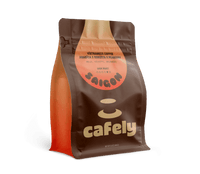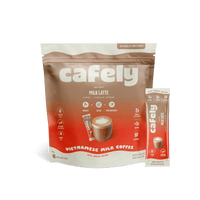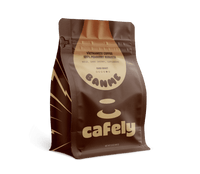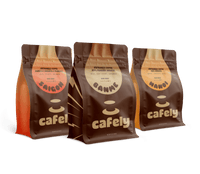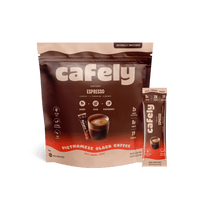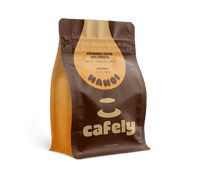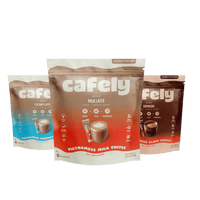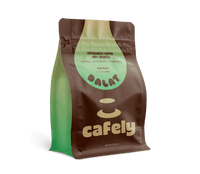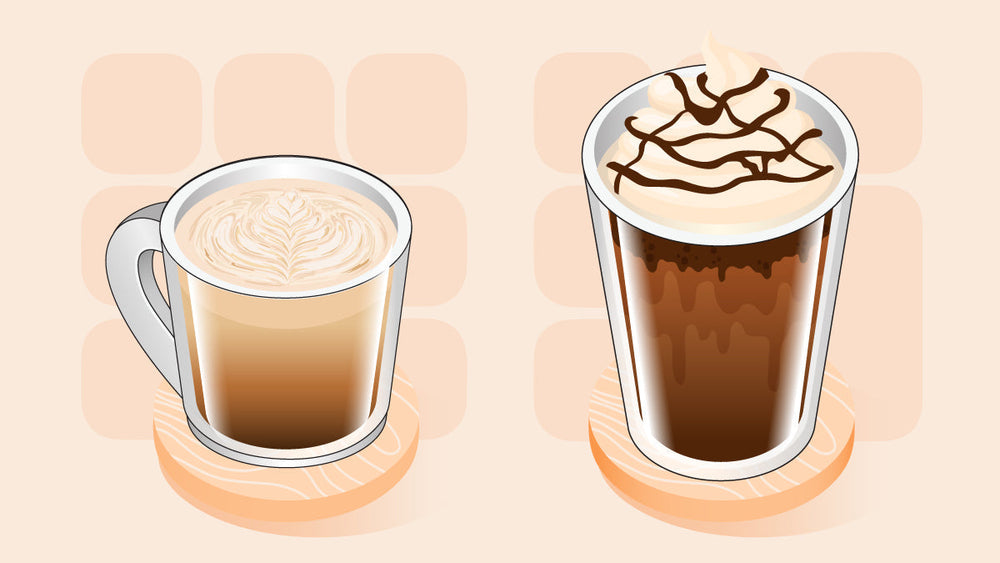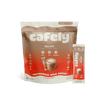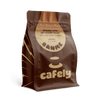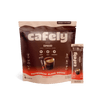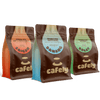Cappuccino vs frappuccino confuses more people than you'd think.
Despite the shared suffix, these two drinks offer totally different coffee experiences.
One is warm, classic, and rooted in espresso culture. The other is cold, creamy, and closer to a dessert than a traditional brew.
If you’re stuck deciding between the two, this guide will walk you through every important detail.
Quick Tip: If you want the flavor profiles of both drinks in one — hot like a cappuccino, iced like a frappuccino — check out VC2 by Cafely, our functional coffee that does both.
Quick Summary: Main Difference Between A Cappuccino & A Frappuccino

Cappuccinos are hot. Frappuccinos are cold.
A cappuccino is made from espresso, steamed milk, and milk foam, usually in equal parts. It’s light on volume but bold on flavor, offering a warm, foamy mouthfeel with no added sugar unless you ask for it.
A Frappuccino, on the other hand, is a blended iced drink, often coffee-based, but sometimes crème-based, with no caffeine at all. It usually includes milk, sweet syrups, ice, and a generous swirl of whipped cream on top. Many versions come flavored with caramel, vanilla, mocha, or seasonal specials.
So, while a cappuccino gives you a warm jolt of classic espresso, a Frappuccino is more like a coffee milkshake, a sweet, indulgent, and refreshing one.
Cappuccino vs. Frappuccino: Taste & Texture
How do they taste and feel?
For cappuccinos, expect a rich, bold espresso flavor with a delicate layer of foam that softens the sip. The foam on top is dry and airy, almost like microbubbles sitting over smooth steamed milk.
There's no sweetness unless you add it, which makes cappuccinos perfect for those who enjoy the taste of coffee itself, without the sugar.
Frappuccinos are a whole different ride. Icy, creamy, and heavily flavored, Frappuccinos feel more like a dessert in a cup.
You’ll often get a cold, slushy base blended with milk and ice, topped with whipped cream and drizzles of caramel, chocolate, or fruity syrups.
Most versions are very sweet, which is not ideal if you’re looking for a bold coffee hit, but great if you're craving something cool and treat-like.
- Cappuccinos are all about balance: espresso, milk, and air.
- Frappuccinos are all about indulgence: cream, sugar, and chill.
Caffeine Content: Which Has More?
A traditional cappuccino is built on a strong base shot of espresso. Most versions include one to two shots, which translates to about 60 to 120 milligrams of caffeine.
It’s a direct, concentrated source of energy that kicks in fast and clean.
Frappuccinos are less predictable. Many are made with a coffee-flavored base that contains significantly less caffeine than espresso, and some skip the coffee entirely, especially the crème-based options.
If you're picking one up from a café like Starbucks, expect caffeine levels to range widely, from almost zero to just under a standard cup of coffee.
If you need a reliable energy boost, the cappuccino wins every time. It may be smaller in size, but the espresso packs a more dependable punch.
Cappuccino vs Frappuccino: Ingredients & Preparation Methods
Cappuccino and Frappuccino come from completely different brewing styles.
A cappuccino is made using:
- Espresso, pulled fresh from a machine
- Steamed milk, heated to a silky consistency
- A final layer of airy milk foam, creating the signature cloud-like top
It’s usually made using an espresso machine, though you can also use a strong stovetop Moka pot and a handheld milk frother at home.
A Frappuccino, by contrast, is a blended beverage built for customization:
- Ice, milk, and flavored syrup form the base
- Some include coffee or espresso, others don’t
- Most are topped with whipped cream and sometimes a syrup drizzle
Everything goes into a blender, making the drink cold, thick, and often very sweet. Originally popularized by Starbucks, Frappuccinos today come in dozens of variations, from caramel and mocha to cookie crumble and seasonal special editions.
If you’re after something straightforward and balanced, a cappuccino is a better option. If you want custom flavor options and a dessert-like vibe, the Frappuccino leans in that direction.
Health & Calories: Which Is Lighter?
If calories in coffee matter for you, there’s a clear difference between cappuccino and frappuccino.
Cappuccinos are usually low in calories, especially if made with skim or plant-based milk. A standard 6-oz cappuccino with low-fat milk lands somewhere around 60 to 80 calories, with no added sugar unless you request it.
Frappuccinos are another story. With syrups, whole milk, whipped cream, and sugar-packed add-ins, the calorie count can quickly reach 250 to 500+ calories per drink. Even a “light” version will often be heavier than a traditional cappuccino.
For a health-conscious choice, the cappuccino is the clear winner, lower in calories, sugar, and saturated fat, and much closer to the kind of drink you can enjoy every day without turning it into a dessert.
Cappuccino vs. Frappuccino: Which One’s Right for You?

Choosing between a cappuccino and a Frappuccino isn't just about temperature; it's about what kind of coffee moment you're craving. Think about what you want in terms of taste, energy, and overall feel.
If you enjoy bold, classic espresso with that signature milk foam texture, go for a cappuccino. It’s great for mornings when you want something warm, light, and low in sugar. It also pairs well with quiet rituals, like a book, a work session, or that first sip before the day starts.
On the other hand, a Frappuccino is your go-to when you're in the mood for a cold, sweet treat. It’s less about the coffee and more about indulgence — think vanilla swirls, caramel ribbons, and a whipped cream crown. It fits perfectly on hot days, post-lunch cravings, or as an afternoon reward when you want something that feels fun and a little over the top.
If health is your focus, the cappuccino is the leaner choice. If flavor and texture variety are what you’re after, the Frappuccino has more room to play.
How to Make a Cappuccino at Home
A cappuccino may seem intimidating, but it’s surprisingly doable once you understand the layers. It’s made up of three parts: a shot (or two) of espresso, steamed milk, and milk foam.
Here’s how to build one, even without a commercial espresso machine.
Step 1: Brew a Strong Espresso Base
Start by brewing one or two shots of espresso. The amount depends on how strong you want your drink. If you have an espresso machine, follow the instructions and make sure your grind is fine and even.
If you don’t have an espresso machine, you can use a stovetop Moka pot or even Cafely’s Instant Espresso, which is a fast, reliable substitute when you want the richness of espresso without the equipment. Just stir a scoop into hot water until it dissolves fully.
Step 2: Heat the Milk
Once your espresso is ready, it’s time to steam the milk. You’ll want whole milk if possible, as it creates the creamiest texture and best foam. Heat about half a cup of milk in a small saucepan or in the microwave until it’s hot but not boiling.
If you see small bubbles forming around the edge, you’re in the right range (about 150°F or 65°C).
Step 3: Froth the Milk
If you have a milk frother, this is where it shines. Froth the milk until you see a thick, airy foam forming at the top.
If you don’t have a frother, you can pour the hot milk into a French press, pump the plunger up and down rapidly for 30 seconds, and watch it double in volume.
Shake the hot milk in a tightly sealed jar, then let it settle for a moment to separate the foam.
Step 4: Layer Your Cappuccino Properly
Pour your hot espresso into a small mug or cup first. Then gently add the steamed milk, hold back the foam with a spoon so it doesn’t go in too soon.
Once your cup is about two-thirds full, scoop the foam on top to finish the drink. You should see clear layers: espresso on the bottom, milk in the middle, and a cloud of foam on top.
Optional Add-Ons
Traditionally, cappuccinos aren’t sweetened. But if you like a little sugar, sprinkle it into the espresso before adding milk.
Some people also dust the foam with cinnamon, cocoa powder, or nutmeg. It’s entirely up to you, just know that the real beauty of a cappuccino is in its simplicity.
How to Make a Frappuccino at Home
A Frappuccino is a totally different process. Instead of brewing and frothing, you’ll be blending. This drink is cold, creamy, and customizable, and while Starbucks may have made it famous, it’s easy to replicate at home with a blender and a few common ingredients.
Here’s how to make a Frappuccino at home:
Step 1: Brew Your Coffee (Then Cool It Down)
A Frappuccino starts with a strong coffee base. You can use espresso, instant coffee, or strong brewed coffee; just make sure it’s bold enough to hold up against the milk and ice.
If you want it quick, Instant Espresso works great here, too. Stir it into a small amount of hot water, then set it aside to cool. If you add hot coffee straight to the blender, it’ll melt the ice too fast and water down the drink.
Step 2: Add Ice, Milk, and Flavor
Once the coffee is cool, it’s time to blend. Add about a cup of ice to your blender, along with half a cup of milk (dairy or non-dairy).
Then pour in your cooled coffee. At this stage, add whatever flavor you’re in the mood for: vanilla extract, chocolate syrup, caramel, or even a spoonful of sweetened condensed milk for richness.
If you want something lighter, stick with unsweetened flavors and low-fat milk. Or go ahead and add a scoop of ice cream or a splash of heavy cream, if you want to make it like dessert.
Step 3: Blend Until Smooth and Creamy
Now hit blend. Start slow and then ramp up to high speed for 30 to 45 seconds until the texture is thick, creamy, and smooth. You’re aiming for something between a milkshake and a slushy.
If the drink feels too thin, add more ice. If it’s too thick to pour, add a splash more milk and blend again. You want a spoonable texture that still sips easily through a straw.
Step 4: Finish with a Topping (Optional, But Encouraged)
Once blended, pour your Frappuccino into a tall glass. For the full café vibe, top it with whipped cream and drizzle on caramel, chocolate syrup, or even crushed cookies.
Flavor Combos to Try at Home
- Mocha Brew: Blend cooled coffee with chocolate syrup and a splash of vanilla
- Vanilla Bean: Skip the coffee, add vanilla extract, and a spoon of vanilla yogurt
- Caramel Coffee: Mix in caramel sauce and a pinch of sea salt for that sweet-salty hit
Frappuccinos don’t have to contain caffeine. If you're making one later in the day, you can use decaf coffee or none at all.
FAQs: Cappuccino vs Frappuccino
These quick answers clear up the common confusion between cappuccino and frappuccino.
1. Is A Frappuccino Just A Frozen Cappuccino?
No, a Frappuccino is a cold, blended drink with sweet flavors, while a cappuccino is a hot espresso-based beverage with milk foam.
2. What Is The Difference Between A Frappe And A Frappuccino?
A frappe is typically made with instant coffee and ice, while a Frappuccino is a Starbucks-branded drink that’s blended with milk, ice, and flavorings.
3. Is Cappuccino The Strongest Coffee?
Not quite, it tastes strong, but drinks like espresso or cold brew have more caffeine per ounce.
4. What Is A Macchiato vs A Cappuccino?

A macchiato contains mostly espresso with a small milk splash, while a cappuccino is foamier and more balanced with milk.
5. What Is A Frappuccino Without Coffee Called?
That’s a crème-based Frappuccino, which has no coffee or caffeine content.
6. Are Cappuccinos Hot Or Cold?
Cappuccinos are traditionally served hot.
7. What Is The Hardest Coffee To Make?
Espresso-based drinks with microfoam and latte art require the most precision and skill.
8. Which Is Healthier, A Flat White Or A Cappuccino?
Cappuccinos are typically lighter, using less milk and containing fewer calories than flat whites.
9. What Is A Cortado vs. A Cappuccino?
A cortado is espresso with a small amount of steamed milk and no foam, while a cappuccino includes more milk and a thick foam layer.
10. What Common Mistake Should Be Avoided When Frothing Milk?
Overheating the milk or creating large, uneven bubbles instead of smooth microfoam is a common mistake.
